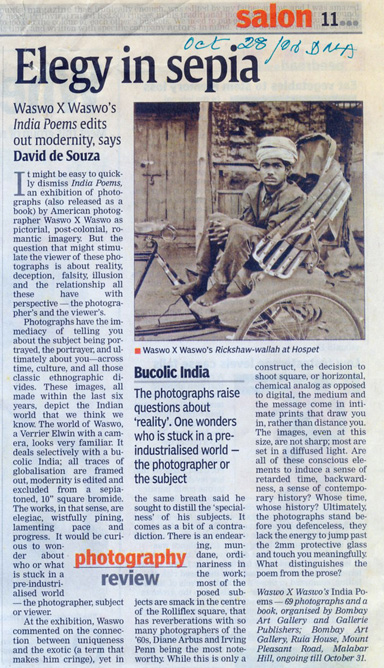It might be easy to quickly dismiss India Poems, an exhibition of photographs and a simultaneous book release by Waswo x Waswo as pictorial, post colonial romantic imagery but the question that might stimulate the viewer of these photographs is about Reality, deception, falsity, illusion and the relationship all these have with perspective, the photographer’s, and yours, the viewer’s.
Photographs have the immediacy of telling you about the subject being portrayed, the portrayer, and then ultimately about you, across time, culture, and all those classic ethnographic divides. These images all made within the last six years depict the Indian world that we think we know. The world of Waswo, the Verrier Elvin with a camera, looks very familiar, it deals selectively with a bucolic India, all traces of globalization are framed out, modernity is edited, excluded from a sepia toned, 10” square bromide. The works in that sense are elegiac, wistfully pining, lamenting pace and progress. It would be curious to wonder about who and what is stuck in a pre-industrialised world.
Waswo in his introductory remarks at the exhibition commented on uniqueness and the connection with the exotic (a term that he cringes against) and then in the same breath continued on to say that he is looking to distill that special-ness in his subjects. It comes as a bit of a contradiction. There is an endearing, mundane, ordinariness in the work; most of the posed subjects are smack in the centre of the Rolliflex square, that has reverberations with so many photographers of the 60s, Arbus and Penn being the most noteworthy. While this is only a construct, a decision to shoot square, or horizontal, chemical analog as opposed to digital, the medium and the message come in intimate prints that draw you in rather than distance you. The images even at this size are not sharp; most are set in a diffused light. Are all of these conscious elements to induce a sense of retarded time, backwardness, a sense of contemporary history? Whose time, whose history? After intentions, authorship, will and desire, ultimately the photographs stand before you defenseless, they lack the energy to jump past the 2mm protective glass and touch you meaningfully.
What distinguishes the Poem from the Prose?
